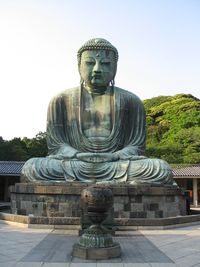البوذية في اليابان
| جزء من سلسلة عن |
| البوذية في اليابان |
|---|
 |
| جزء من سلسلة مقالات عن |
| بوذية ماهايانا |
|---|
 |
البوذية مورست في اليابان منذ دخولها الرسمي في 552 م حسب نيهون شوكي[1] from Baekje, Korea by Buddhist monks.[2][3] Although some Chinese sources place the first spreading of the religion earlier during the Kofun period (250 to 538).[بحاجة لمصدر] Buddhism has had a major influence on the development of Japanese society and remains an influential aspect of the culture to this day.[4]
أما في الأزمنة الحديثة، فإن أشهر مدارس البوذية في اليابان هي بوذية الأرض الطاهرة, Nichiren Buddhism, Shingon Buddhism and Zen. As of 2008 approximately 34% of the Japanese identify as Buddhists and the number has been growing since the 1980s, in terms of membership in organized religion. However in terms of practice, 75% practice some form of Buddhism (compared with 90% practicing Shinto, thus most Japanese practice both to some extent).[5] About 60% of the Japanese have a Butsudan (Buddhist shrine) in their homes.[6]
تاريخ البوذية اليابانية
وصول البوذية إلى الصين عبر طريق الحرير
وصول البوذية إلى اليابان is ultimately a consequence of the first contacts between China and Central Asia, where Buddhism had spread from the Indian subcontinent. These contacts occurred with the opening of the Silk Road in the 2nd century BCE, following the travels of Zhang Qian between 138 and 126 BCE. These contacts culminated with the official introduction of Buddhism in China in 67 CE. Historians generally agree that by the middle of the 1st century, the religion had penetrated to areas north of the Huai River in China.[7]
فترة كـُفون (250 إلى 538)
انظر أيضاً
- الفلسفة البوذية
- تاريخ البوذية
- Ichibata Yakushi Kyodan
- Kaichō
- Kanjin
- Nara National Museum
- Religion in Japan
- Shinbutsu-shūgō
- Zen at War
ملاحظات
الهامش
- ^ Bowring, Richard John (2005). The religious traditions of Japan, 500–1600. Cambridge, UK: Cambridge University Press. pp. 16–17. ISBN 0-521-85119-X.
- ^ Bowring, Richard John (2005). The religious traditions of Japan, 500–1600. Cambridge, UK: Cambridge University Press. pp. 15–17. ISBN 0-521-85119-X.
- ^ Dykstra, Yoshiko Kurata; De Bary, William Theodore (2001). Sources of Japanese tradition. New York: Columbia University Press. p. 100. ISBN 0-231-12138-5.
- ^ Asia Society Buddhism in Japan, accessed July 2012
- ^ [Japan, Destination Detectives, Jen Green, Capstone Classroom, 2006, p. 20]
- ^ [Japanese Saints: Mormons in the Land of the Rising Sun, John Patrick Hoffmann, Lexington Books, 2007 p. 37]
- ^ Hoffman, Michael, "Buddhism's arrival, Shinto's endurance", Japan Times, March 14, 2010, p. 7.
ببليوجرافيا
- Buswell, Robert; Lopez, Donald S. (2013). The Princeton Dictionary of Buddhism. Princeton University Press. ISBN 978-0-691-15786-3.
{{cite book}}: Invalid|ref=harv(help) - Rahder, Johannes. "Harivarman's Satyasiddhi-sastra". Philosophy East & West, V. 5 (January, 1956) p. 348.
- Shi, Zhangqing (2004). The Two Truths in Chinese Buddhism. Motilal Banarsidass Publ. ISBN 978-81-208-2035-7.
{{cite book}}: Invalid|ref=harv(help) - Takakusu, Junjirō (2002). The Essentials of Buddhist Philosophy. Motilal Banarsidass Publ. ISBN 978-81-208-1592-6.
{{cite book}}: Invalid|ref=harv(help) - Sharf, Robert H. (August 1993), "The Zen of Japanese Nationalism", History of Religions 33 (1): 1–43, http://www.thezensite.com/ZenEssays/HistoricalZen/Zen_of_Japanese_Nationalism.html
- Snelling, John (1987), The Buddhist handbook. A Complete Guide to Buddhist Teaching and Practice, London: Century Paperbacks
- Yoshiro Tamura (2005), Japanese Buddhism, A Cultural History, Kosei Publishing Co., ISBN 4-333-01684-3
- Victoria, Brian Daizen (2006), Zen at war (Second ed.), Lanham e.a.: Rowman & Littlefield Publishers, Inc.
للاستزادة
- Asakawa, K., and Henry Cabot Lodge (Ed.). Japan From the Japanese Government History.
- Eliot, Sir Charles. Japanese Buddhism. London: Kegan Paul International, 2005. ISBN 0-7103-0967-8. Reprint of the 1935 original edition.
- Bunyiu Nanjio (1886). A short history of the twelve Japanese Buddhist sects, Tokyo: Bukkyo-sho-ei-yaku-shupan-sha
- Covell, Stephen (2001). "Living Temple Buddhism in Contemporary Japan: The Tendai Sect Today". Comparative Religion Publications. Paper 1. (Dissertation, Western Michigan University)
- Covell, Stephen G. (2006). "Japanese Temple Buddhism: Worldliness in a Religion of Renunciation", Univ of Hawaii. ISBN 0824829670
- Horii, Mitsutoshi (2006). Deprofessionalisation of Buddhist Priests in Contemporary Japan. A Socio-Industrial Study of a Religious Profession, Electronic Journal of Contemporary Japanese Studies 6 (1), unpaginated
- Kawanami, Hiroko: Japanese Nationalism and the Universal Dharma, in: Ian Harris (ed.): Buddhism and Politics in Twentieth-Century Asia. London/New York: Continuum, 1999, pp. 105–126. ISBN 978-0-8264-5178-1
- Matsunaga, Daigan; Matsunaga, Alicia (1996), Foundation of Japanese buddhism, Vol. 1: The Aristocratic Age, Los Angeles; Tokyo: Buddhist Books International. ISBN 0-914910-26-4
- Matsunaga, Daigan, Matsunaga, Alicia (1996), Foundation of Japanese buddhism, Vol. 2: The Mass Movement (Kamakura and Muromachi Periods), Los Angeles; Tokyo: Buddhist Books International, 1996. ISBN 0-914910-28-0
- Matsunami, Kodo (2004), A Guide to Japanese Buddhism, Tokyo: Japan Buddhist Federation, Archived from the original on February 2, 2013, https://web.archive.org/web/20130202003246/http://www.buddhanet.net/pdf_file/guidejapanbuddhismbm6.pdf



